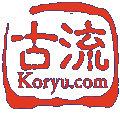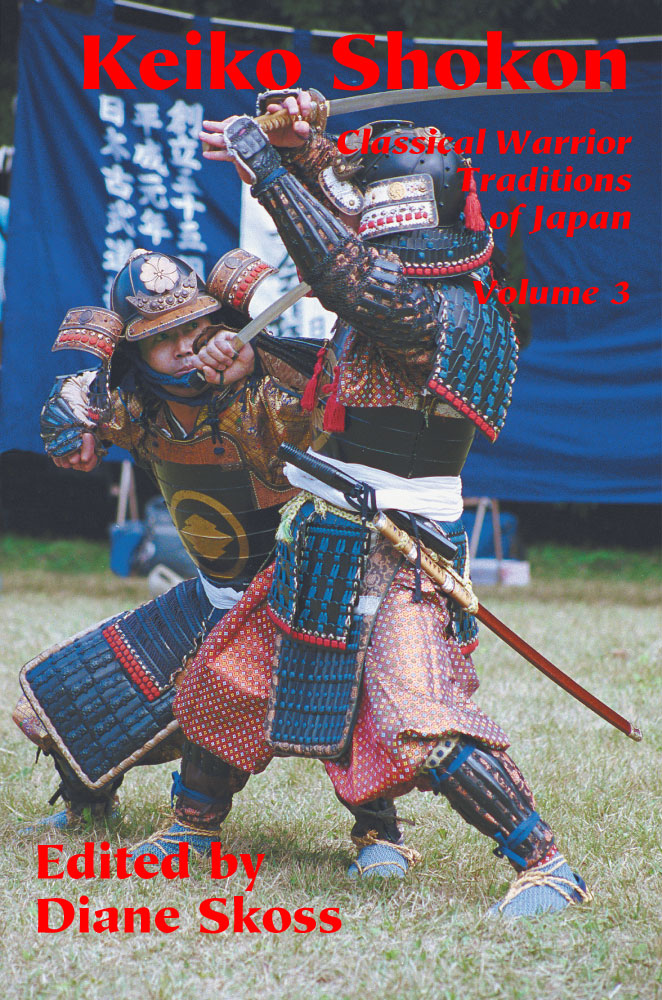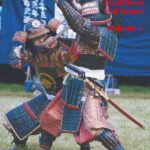Keiko Shokon
$21.95 (+ shipping)
The Classical Warrior Traditions of Japan, volume 3.
Edited by Diane Skoss
Published by Koryu Books, 2002.
ISBN: 1-890536-06-7.
6″ x 9″ paperback, 208 p., with 22 illustrations.
Includes bibliographical references, and complete glossary/index.
Kindle Edition: Keiko Shokon: Classical Warrior Traditions of Japan, 3
Keiko Shokon translates as “Reflecting deeply on the past, illuminate the present.” In this, the 3rd volume in Diane Skoss’s remarkable series “Classical Warrior Traditions of Japan” she does this beautifully. This volume includes Karl Friday’s masterful translation of the Neko No Myoyujtsu one of my favorite parables of ancient Japan concerning the warrior. There is a wonderful interview with Nitta Suzuyo, head of Toda-ha Buko Ryu. William Bodiford has contributed an article which should put to rest the use and abuse of the term “soke” in the west, and George H. Bristol, Lieutenant Colonel, USMC has provided a rather modern practical consideration of koryu budo in his essay The Professional Perspective: Thoughts on the Koryu Bujutsu from a United States Marine. Other contributors include Ellis Amdur, Meik Skoss, Dave Lowry, Quintin Chambers, Liam Keeley and Ron Beaubien. This book is one that anyone who considers themselves serious about understanding the nature and history of Japanese budo, ancient or modern, must have and read and reread.
Peter Boylan
Mugendo Budo
Deftly edited by Diane Skoss (who holds black belts in several modern martial arts, as well as the classical licenses of okuden in Toda-ha Buko-ryu naginatajutsu, and okuiri-sho, Shinto Muso-ryu jojutsu), Keiko Shokon: Classical Warrior Traditions Of Japan is the third in a fascinating series of compiled of essays and interviews. Of special note are those contributions which are expertly translated from Japanese and focus upon the traditions, martial disciplines, and way of life of the warrior in pre-industrial Japan. From a U.S. marine’s observations on the Japanese warrior traditions, to an overview of the wide variety of sword arts and the men who founded them, Keiko Shokon presents a wealth of information and knowledgeable opinions. Keiko Shokon is especially recommended reading for anyone interested in learning more about the history and traditions of Japanese swordsmanship.
John Taylor, The Midwest Book Review, August 2002
Five years after the publication of their first volume and three years after the second, Koryu Books have issued their third and final volume of the series on the classical Japanese martial arts: Keiko Shokon: Classical Warrior Traditions of Japan. The publication is an important event for all those interested in the koryu, due to the level of authority and scholarly ability that their offerings bring to the world of Japanese martial arts publications.
The first volume of the trilogy introduced the reader to the fundamental structures of the koryu bujutsu in form, concept and present status. It also illustrated and defined a template for the discussion and illustration of these little known arts. The second volume continued this pattern further leading the reader toward a richer understanding of the principles and internal make-up of these traditions. The third volume follows this evolutionary path, leading the reader onward not by overloading them with technicalities but by offering a relaxed and informal series of articles.
Each article in the latest volume delivers the level of authenticity that we have come to expect from Koryu Books while offering topics that speak clearly to the contemporary practitioner of the classical arts. It answers both questions that they may already have and which they perhaps should be asking of themselves and their traditions.
The book can be roughly split into four types of essays: scholarly researched articles provided by Dr.’s Friday and Bodiford; personal experiences and observations, provided by Messrs Lowry, Beaubien, Amdur and Bristol; an interview provided by Liam Keeley; and, a basic introduction to some koryu traditions provided by Meik Skoss. In these articles each writer offers their own differing, yet concentric, views and experiences that in sum achieve a strong and impressive holistic offering…..
The publications of Koryu Books have effectively paralleled the evolution of their audience. Where previously simple questions on the most basic of matters were the norm, today’s highly-informed readers demand a far greater level of scholarship and depth of understanding. Koryu Books have not only responded to this challenge but have led the field in providing the highest quality materials from contributors who are able to impart knowledge both articulately and authoritatively.
Their books have acted as introducers, guides and finally intimate confidantes to practitioners and, as such, are imperatives for the koryu practitioner’s bookshelf. They also offer fine examples of how to approach the study and introduction of classical traditions of other cultures to hoplologists and all others interested in the traditional Martial Arts of Japan.
Antony Cundy
Hop-lite, No. 13, Fall 2002, p. 17-19.
Judo, karate, kendo, aikido–most of the Japanese martial arts, as practiced today–are relatively recent inventions, taking shape in the era of Japanese nationalism, military build-up, and expansion following the Meiji Restoration. Their forms reflect their times: They are characterized by regimented group practice, a focus on building spirit, an emphasis on competition, and strict systems of ranking. Contrast this with the koryu bujutsu, which are, broadly defined, the martial arts of pre-Meiji Restoration-era Japan. Rather than the hierarchies of the gendai budo, including governing bodies, the koryu are passed down in ryu, semi-feudal “family” traditions, and their pedagogical method is completely different. The late, great Donn Draeger was the first Westerner to bring widespread attention to the koryu bujutsu. Yet, Draeger’s writings presented only one point of view of a complex subject, and left many misconceptions, such as the oft cited “-do” versus “-jutsu” controversy.
Diane Skoss, like Draeger, is a writer who spent many years living in Japan, drinking from the wellspring of these rare arts. Unlike Draeger, her books combine a multiplicity of voices, being composed of essays written by eminent authorities on the classical Japanese martial arts. The first book in Skoss’ series, “Classical Warrior Traditions of Japan,” sought to define what the koryu bujutsu are. The second tried to approach the essence of these arts. Her third book, however, is concerned not with the past or present, but with the future. What lies ahead for the koryu bujutsu in a world grown increasingly impersonal and mechanized, where “martial arts,” to many Japanese, means high-school Phys Ed. kendo, and in which many of those most interested in learning these arts are, in fact, non-Japanese? Can the koryu be successfully transplanted to foreign soil? Does their spirit change?
Essays in this book include a Japanese parable on the nature of skill in the fighting arts, translated by Karl F. Friday; an essay by Dave Lowry on the dangers of attempting to study more than one koryu (which should be required reading for anyone purporting to follow a regimen of “cross-training”); Liam Keeley’s interview with Nitta Suzuyo, the headmaster of the Toda-ha naginata ryu; Ron Beaubien’s insightful observation on the difficulty of trying to leanr about the koryu by mere observation; an overview of the methods and practice of Itto-ryu kenjutsu; a discourse by William M. Bodiford on what exactly the often-misused term “soke” actually means; Ellis Amdur’s essay on the perils of trying to improve on centuries-old traditions; and, finally, United States Marine Corps Lieutenant Colonel George H. Bristol’s observations on the koryu as fighting arts and combat training.
Keiko Shokon, as well as the first two books in the series, is well worth reading by anyone interested in the history behind our modern practice of Japanese martial arts. For those who wish to practice the koryu bujutsu themselves, they are an invaluable resource. Finally, the philosophical questions they raise on such issues as change and tradition are well worth considering in and of themselves. This book is highly recommended.
Ken Mondschein
FightingArts.com
Contents:
- Foreword
- by Quintin Chambers
- Keiko Shokon Revisited: An Introduction
- by Diane Skoss
- The Cat’s Eerie Skill: A Translation of Issai Chozan’s “Neko no Myojutsu”
- by Karl F. Friday
- Promise and Peril: The Potential of Following Multiple Koryu
- by Dave Lowry
- Interview with Nitta Suzuyo: Headmaster of the Toda-ha Buko-ryu
- by Liam Keeley
- Challenges in Observing the Koryu Bugei
- by Ron Beaubien
- Itto-ryu Kenjutsu: An Overview
- by Meik Skoss
- Soke: Historical Incarnations of a Title and its Entitlements
- by William M. Bodiford
- Renovation and Innovation in Tradition
- by Ellis Amdur
- The Professional Perspective: Thoughts on the Koryu Bujutsu from a United States Marine
- by George H. Bristol
- Index
- with glossary


